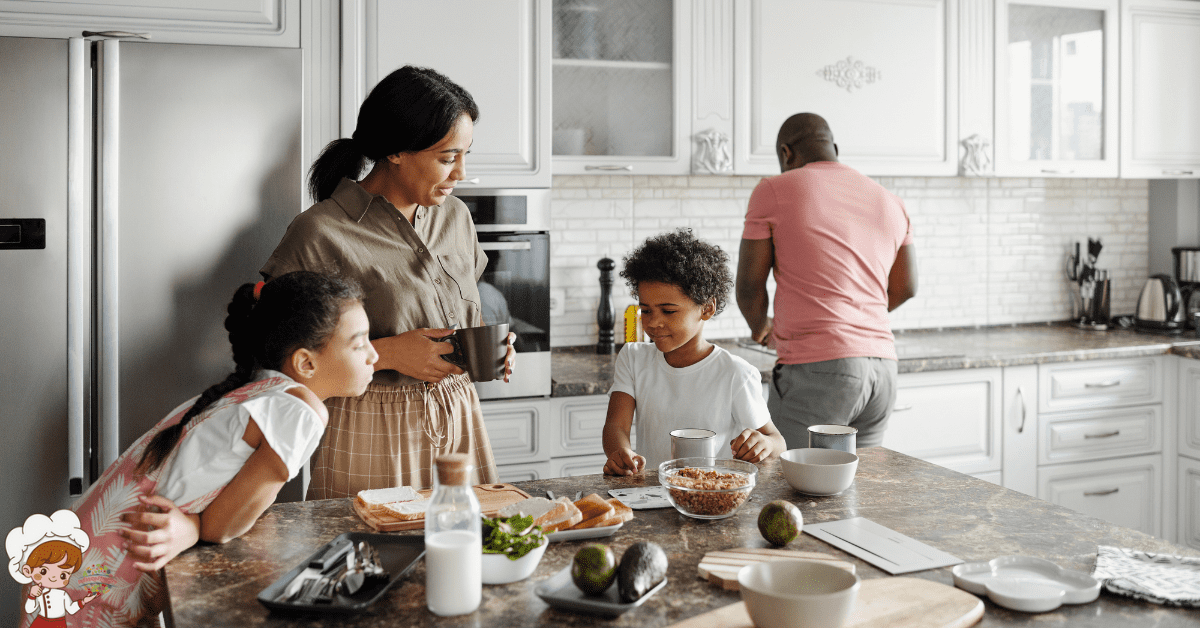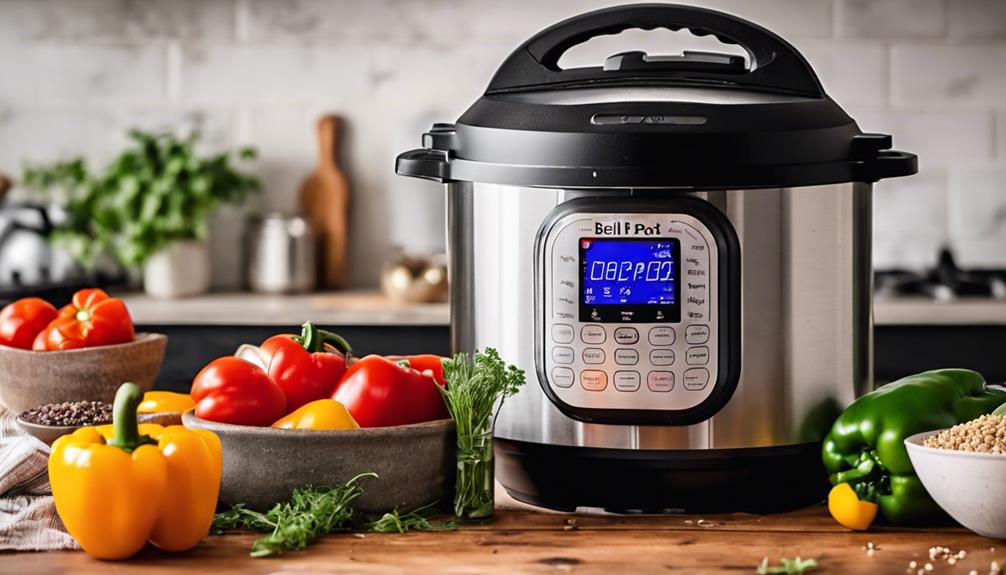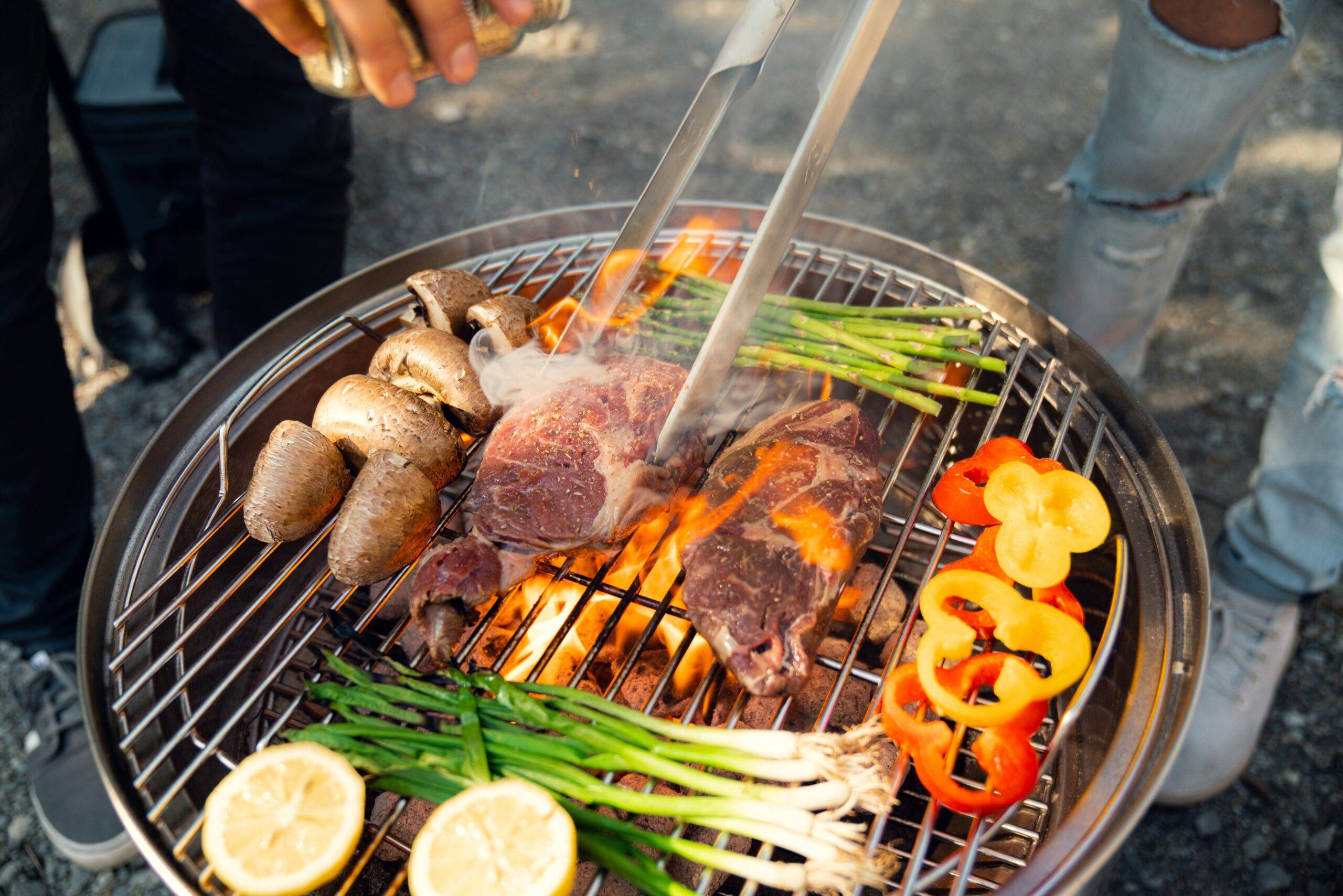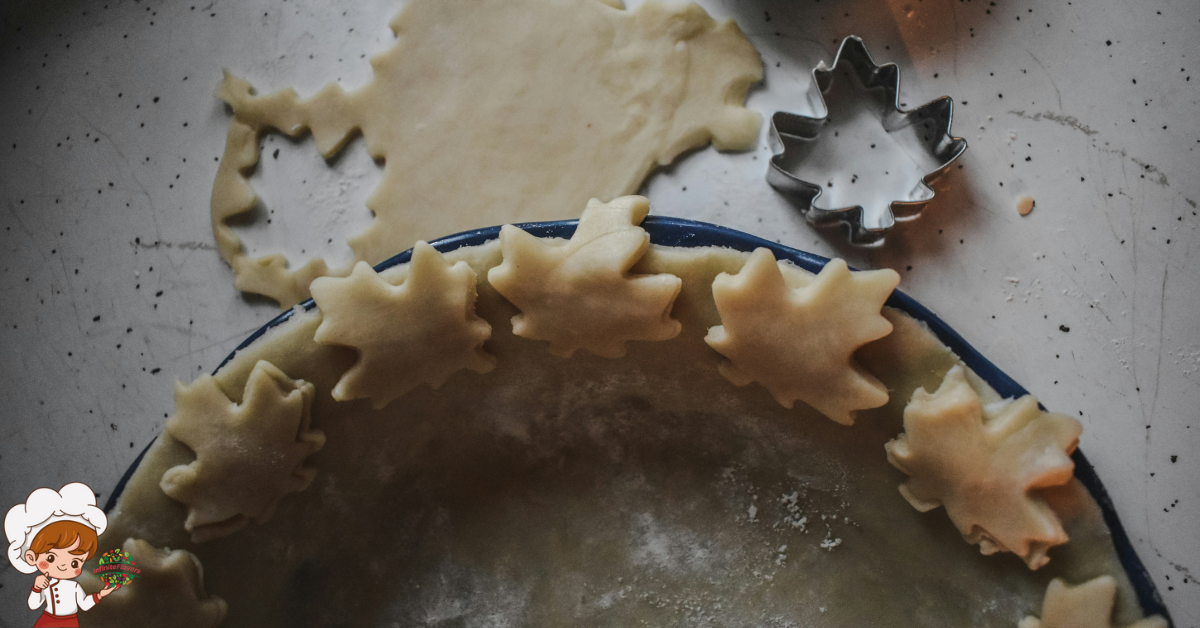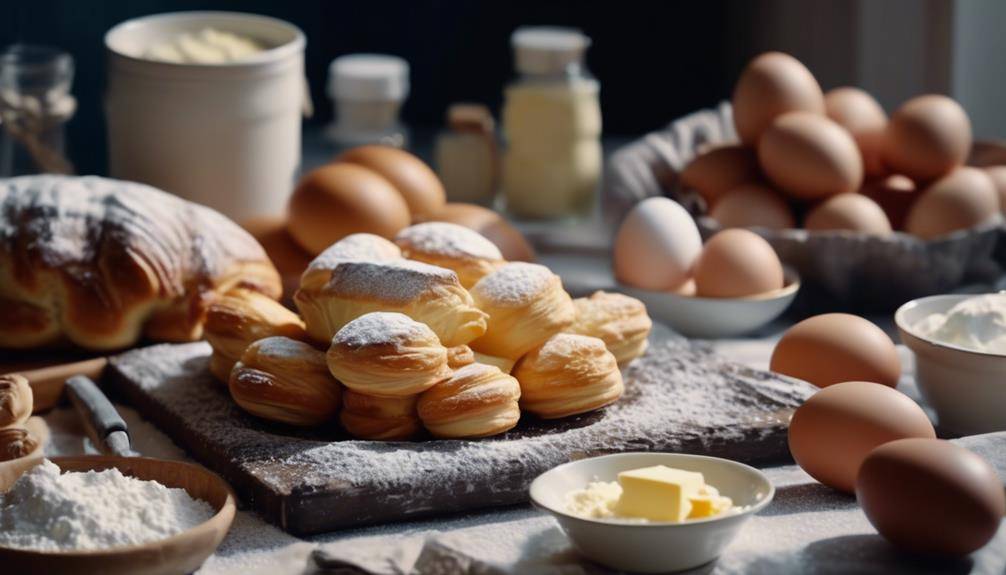The 5 Best Advanced Techniques For Pastry Creation
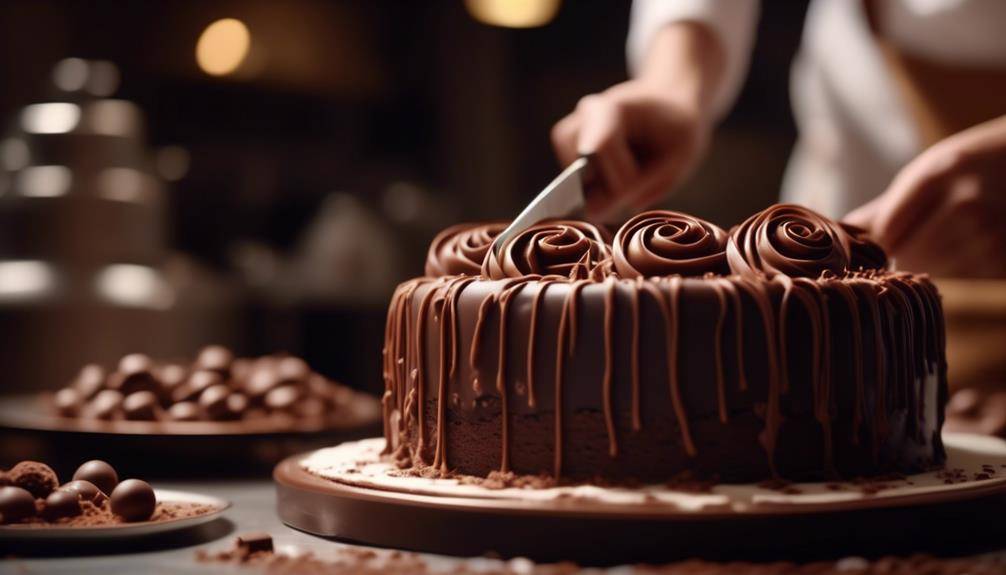
Techniques For Pastry Creation; When it comes to creating exceptional pastries, you need to go beyond the basics and explore advanced techniques that will elevate your culinary skills. Mastering laminated dough, perfecting puff pastry, understanding choux pastry tricks, exploring advanced cake layering, and enhancing flavors with infused syrups are all essential skills that will take your pastry creations to the next level. But why stop there? There’s so much more to discover, so many more techniques waiting to be explored. So, if you’re ready to take your pastry game up a notch, join us as we uncover the secrets of these five advanced techniques and unlock a world of endless possibilities for your sweet creations.
Mastering Laminated Dough
To truly excel in the art of pastry making, you must master the intricate skill of creating laminated dough. Laminated dough is the foundation for creating delicate and flaky pastries such as croissants, puff pastry, and Danish pastries. The key to achieving maximum flakiness lies in the careful layering of butter and dough.
To start, the dough is rolled out into a thin sheet and then a layer of butter is added. This process is repeated several times, creating multiple layers of butter and dough. As the pastry bakes, the butter melts and creates steam, which causes the layers to separate and puff up, resulting in a light and flaky texture.
However, working with laminated dough can be challenging, and troubleshooting common issues is crucial. One common problem is the butter melting while rolling out the dough. To prevent this, it is essential to keep the dough and butter at the same temperature. If the butter becomes too soft, refrigerate the dough for a few minutes to firm it up.
Another issue that may arise is uneven layering, which can result in uneven rising and baking. To avoid this, make sure to roll the dough and butter to an even thickness and distribute it evenly across the dough. Take your time and be patient, as precision is key in achieving perfect laminated dough.
Perfecting Puff Pastry
Mastering the art of creating laminated dough sets a strong foundation for perfecting puff pastry, elevating your pastry skills to new heights. To achieve the perfect puffiness in your puff pastry, there are a few key techniques that you must master.
First, it is crucial to ensure that your dough is properly chilled before baking. This allows the layers of butter within the dough to solidify, creating pockets of steam during baking that result in the desired puffiness. Be sure to refrigerate your dough for at least 30 minutes before rolling it out and shaping it.
Next, when rolling out your dough, be gentle and avoid applying too much pressure. This will help to preserve the delicate layers of butter and flour, allowing them to separate and create the flaky texture characteristic of puff pastry. Use a light touch and roll the dough in one direction, turning it occasionally to ensure even thickness.
Another important technique is to fold and turn your dough multiple times during the rolling process. This helps to create even distribution of butter and flour, which in turn leads to consistent puffiness. Aim to fold your dough into thirds, like a letter, and turn it 90 degrees before rolling it out again.
Understanding Choux Pastry Tricks
Ready to elevate your pastry game? Let’s uncover the secrets to perfecting the texture of choux pastry, so you can achieve those irresistibly puffy profiteroles. But it doesn’t stop there – we’ll also explore the art of decorating choux masterpieces, taking your creations to a whole new level of elegance and sophistication. Get ready to impress with your choux pastry skills.
Perfecting Choux Texture
By implementing certain techniques, you can elevate the texture of your choux pastry to achieve perfection. Here are four tricks to help you achieve lightness and perfect crispiness in your choux creations:
- Whip it good: Whisk your choux dough vigorously to incorporate air and create a light and airy texture. This will result in a delicate and fluffy pastry.
- Control the moisture: Pay close attention to the moisture content of your dough. Too much moisture can make your choux pastry heavy and dense. Add the eggs gradually and only as needed to achieve the right consistency.
- Bake it right: Preheat your oven to a high temperature and then lower it once you put in the choux. This temperature shock will create a crisp exterior while maintaining a soft interior.
- Don’t rush the drying process: Once your choux pastry is baked, leave it in the turned-off oven for a few minutes to ensure that it dries out completely. This step will help maintain its crispiness.
Achieving Puffy Profiteroles
To achieve beautifully puffy profiteroles, mastering the tricks of choux pastry is essential. Achieving a consistent rise in your profiteroles can be a challenge, but with a few troubleshooting tips, you can overcome common problems. One common issue is profiteroles that don’t rise enough or collapse after baking. This could be due to undercooked batter or not incorporating enough air into the dough. To fix this, ensure that you cook the dough long enough on the stovetop and beat the eggs into the batter vigorously.
Another problem you may encounter is profiteroles that spread too much and lose their shape. This can be caused by using too much liquid or not baking the choux pastry at a high enough temperature. To prevent this, measure your ingredients precisely and bake the profiteroles at a high temperature initially, then reduce the temperature to allow them to dry out properly. By following these tips, you can achieve perfectly puffy profiteroles every time.
Decorating Choux Masterpieces
Mastering the art of choux pastry opens up a world of possibilities for creating stunning and intricately decorated choux masterpieces. To take your choux creations to the next level, here are four choux pastry techniques that will elevate your decorating game:
- Piping Perfection: Invest in a good quality piping bag and tips to create precise and uniform shapes. Experiment with different nozzle sizes to achieve various designs, from delicate rosettes to elegant swirls.
- Flavorful Fillings: Don’t just stop at the shell; infuse your choux pastries with delicious flavors. Try adding aromatic extracts, like vanilla or almond, to your pastry dough. Fill your creations with luscious creams, mousses, or even fruity compotes for an explosion of taste.
- Glazing and Garnishing: Create a glossy finish by glazing your choux pastries with a sweet syrup or melted chocolate. Then, top them off with colorful sprinkles, chopped nuts, or edible flowers for an extra touch of elegance.
- Artistic Accents: Take inspiration from the world of art and use edible paints or food coloring to add intricate designs or patterns to your choux pastries. Incorporate techniques like marbling, stenciling, or airbrushing to create visually stunning masterpieces.
With these choux pastry tricks up your sleeve, your creations will not only taste amazing but also look like works of art. Get ready to impress your guests with your stunning and delicious choux masterpieces.
Exploring Advanced Cake Layering
Enhance your cake creations with the artistry of advanced layering techniques. By exploring cake flavors and experimenting with cake textures, you can take your cakes to a whole new level of sophistication and delight.
When it comes to exploring cake flavors, the possibilities are endless. You can go beyond the traditional vanilla and chocolate and delve into exotic options like matcha green tea, lavender-infused, or even Earl Grey. By incorporating unique flavors into your cake layers, you can surprise and captivate your taste buds, creating a truly memorable experience for anyone who takes a bite.
But it’s not just about the flavors; it’s also about the textures. Experimenting with cake textures allows you to add another dimension to your creations. You can play with light and airy sponge cakes, dense and fudgy brownie layers, or even crunchy biscuit layers. By combining different textures in a single cake, you can create a symphony of sensations that will leave your guests in awe.
To achieve advanced cake layering, precision is key. Each layer must be perfectly baked, leveled, and assembled to achieve a harmonious balance of flavors and textures. Take your time to ensure each layer is evenly spread with fillings, frostings, or ganaches, creating a seamless integration of ingredients.
Advanced cake layering requires a creative eye and meticulous attention to detail. It is an art form that allows you to showcase your skills and imagination. So go ahead, explore new flavors, experiment with different textures, and let your cake creations become a masterpiece of taste and design.
Enhancing Flavors With Infused Syrups
As you continue your journey into advanced cake layering, prepare to elevate your creations even further by exploring the art of enhancing flavors through infused syrups. Infused syrups are a fantastic way to add depth and complexity to your cakes, and with the right flavor pairing techniques and infusion methods, you can take your pastry creations to a whole new level. Here are four techniques to consider:
- Fruit Infusions: Experiment with infusing your syrups with the essence of fresh fruits. Whether it’s juicy berries, tangy citrus, or tropical mangoes, the natural flavors of fruits can add a burst of freshness to your cakes. Simply simmer the fruit with sugar and water, strain the mixture, and let the syrup infuse your cake layers.
- Herb and Spice Infusions: Don’t be afraid to get creative with herbs and spices. Infusing your syrups with ingredients like vanilla bean, cinnamon sticks, or fresh mint can add a subtle yet enchanting flavor profile to your cakes. Just be sure to strain the syrup before using it to ensure a smooth texture.
- Alcohol Infusions: For a sophisticated twist, consider infusing your syrups with a splash of your favorite spirits. From rum and bourbon to liqueurs like Grand Marnier or Amaretto, alcohol can enhance the flavors of your cakes and add a hint of warmth and complexity.
- Floral Infusions: Delicate floral flavors can bring a touch of elegance to your cakes. Consider infusing your syrups with lavender, rose petals, or elderflower for a fragrant and enchanting twist. Remember to use edible flowers and strain the syrup thoroughly to avoid any unwanted textures.
With these flavor pairing techniques and infusion methods, you can elevate your cakes to a whole new level of deliciousness. So, get creative, experiment with different flavors, and prepare to amaze your taste buds with the enchanting world of infused syrups.
Elevating Fillings With Sous Vide Techniques
Ready to take your pastry creations to the next level? With sous vide techniques, you can infuse your fillings with incredible flavors, ensuring every bite is bursting with taste. Not only that, but sous vide also enhances the texture and consistency of your fillings, resulting in a smooth and velvety mouthfeel. Get ready to explore unique ingredient combinations and elevate your pastries to new heights.
Flavor Infusion With Sous Vide
Unlock a world of flavor possibilities by harnessing the power of sous vide to infuse fillings with unique and tantalizing tastes. Enhancing pastry flavors has never been easier with these sous vide flavor infusion techniques:
- Sous Vide Fruit Compote: By vacuum sealing fresh fruits with sugar and spices, and cooking them at a precise temperature, you can create a perfectly balanced and intensely flavorful fruit compote. The sous vide method ensures that the fruits retain their natural sweetness and aroma.
- Infused Creams and Custards: Sous vide allows for precise control over temperature, ensuring that flavors are infused evenly into creams and custards. By infusing ingredients like vanilla beans, herbs, or even tea leaves, you can achieve a depth of flavor that traditional methods can’t match.
- Herb and Spice-Infused Fillings: Sous vide is the ideal technique for infusing fillings with the essence of herbs and spices. Whether it’s infusing butter with rosemary or cinnamon-infused cream, sous vide ensures that the flavors are concentrated and well-distributed throughout the filling.
- Alcohol-Infused Fillings: Sous vide is perfect for infusing fillings with the flavors of your favorite spirits. From bourbon-infused chocolate ganache to rum-soaked fruit fillings, sous vide allows you to create fillings with a rich and complex flavor profile.
With sous vide flavor infusion, you can take your pastry creations to a whole new level of taste and complexity.
Enhanced Texture and Consistency
Elevate the texture and consistency of your pastry fillings to new heights with the precise and controlled sous vide techniques. By utilizing sous vide, you can achieve unparalleled results in improving the crumb structure and achieving flaky layers in your pastries. Sous vide cooking involves vacuum-sealing the filling ingredients in a bag and cooking them at a precise temperature in a water bath.
This gentle and even cooking method ensures that the ingredients are cooked evenly, resulting in a smooth and consistent texture. The controlled temperature also helps to prevent overcooking or undercooking, allowing you to achieve the perfect consistency every time. Whether you’re making custard fillings, fruit compotes, or savory fillings, sous vide techniques can take your pastry creations to the next level in terms of texture and consistency.
Unique Ingredient Combinations
With sous vide techniques, you can explore exciting and innovative combinations of ingredients to create one-of-a-kind fillings that will elevate your pastry creations to new culinary heights. Here are four unique ingredient pairings that can help you achieve unconventional flavor profiles:
- Bacon and Maple Syrup: The smoky and salty flavor of bacon combined with the sweet and rich taste of maple syrup is a match made in heaven. Sous vide allows you to infuse the flavors together, resulting in a harmonious blend that will add depth to your pastries.
- Goat Cheese and Fig: The tanginess of goat cheese paired with the sweet and earthy flavor of figs creates a delightful contrast that will surprise and delight your taste buds. Sous vide ensures that the flavors meld together perfectly, creating a creamy and luscious filling.
- Matcha and White Chocolate: The vibrant and grassy notes of matcha combined with the creamy sweetness of white chocolate create a unique and sophisticated flavor profile. Sous vide allows you to infuse the matcha into the white chocolate, resulting in a smooth and balanced filling.
- Lavender and Honey: The floral and aromatic flavor of lavender paired with the natural sweetness of honey creates a delicate and fragrant combination. Sous vide ensures that the flavors are infused evenly, resulting in a filling that is both elegant and delicious.
Achieving Airy Meringue Perfection
To achieve the perfect airy meringue, you can consider incorporating a gentle folding technique while whisking the egg whites. This technique is crucial for achieving fluffy soufflé perfection and creating delicate macarons. When whisking the egg whites, it is important to start with fresh, room temperature eggs. The eggs should be separated carefully, ensuring that no trace of yolk contaminates the whites. Use a clean, dry bowl and whisk to beat the egg whites, adding a pinch of salt to stabilize the foam. Begin whisking at a low speed, gradually increasing the speed as the whites start to foam.
Once the foam becomes frothy, add in the sugar slowly, a tablespoon at a time. Continue whisking until the meringue forms stiff peaks that hold their shape. At this point, it is time to incorporate the folding technique. Take a rubber spatula and gently cut through the mixture, scooping from the bottom and folding it over the top. Repeat this motion until the sugar is fully incorporated and the mixture is smooth and glossy.
Be careful not to overmix, as this can deflate the air bubbles and result in a dense meringue. The gentle folding technique ensures that the air pockets are preserved, creating a light and airy meringue. So, the next time you are aiming for meringue perfection, remember to whisk and fold with care, and you will achieve the desired results.
Creating Velvety Custards and Creams
Create velvety custards and creams that will melt in your mouth with the perfect balance of ingredients and cooking techniques. When it comes to creating these indulgent treats, attention to detail is key. Here are four essential techniques to help you achieve the creamiest, dreamiest results:
- Whisking: Whisking is an integral step in creating velvety custards and creams. It helps incorporate air into the mixture, resulting in a lighter texture. Use a wire whisk and whisk vigorously, making sure to reach all corners of the pot to prevent any lumps from forming.
- Tempering: When adding hot liquids to eggs or cream, tempering is crucial to prevent curdling. Slowly pour a small amount of the hot liquid into the egg mixture while whisking continuously. This will gradually raise the temperature of the eggs or cream, allowing them to blend seamlessly with the hot liquid.
- Straining: To achieve a smooth and silky texture, always strain your custards and creams. This step removes any lumps, cooked egg bits, or impurities, resulting in a velvety consistency that will make your taste buds dance with delight.
- Chilling: After cooking your custards and creams, it is essential to chill them properly. This not only helps them set but also allows the flavors to develop and intensify. Cover the surface of the custard or cream with plastic wrap to prevent a skin from forming, and refrigerate for at least a few hours or overnight for the best results.
Mastering Sugar Work for Stunning Decorations
Are you ready to take your pastry creations to the next level? Mastering sugar work is the key to creating stunning decorations that will wow your guests. From sugar sculpting techniques to edible sugar art and sugar pulling mastery, these skills will elevate your pastries from ordinary to extraordinary. So, roll up your sleeves and get ready to learn the art of sugar work.
Sugar Sculpting Techniques
Enhance your pastry creations with the mastery of sugar sculpting techniques, creating stunning decorations that will leave a lasting impression. Here are four advanced sugar decoration techniques to help you elevate your pastry game:
- Pulled Sugar: This technique involves heating sugar to a high temperature and then pulling and stretching it to create delicate, intricate designs. From flowers to ribbons, the possibilities are endless with pulled sugar.
- Blown Sugar: Take your sugar sculptures to the next level by incorporating air into the mix. Blown sugar allows you to create hollow structures like delicate spheres or even intricate sugar cages.
- Isomalt Art: Isomalt is a type of sugar substitute that can be melted and molded into various shapes. Use it to create stunning edible sugar sculptures that will wow your guests.
- Sugar Casting: This technique involves pouring molten sugar into molds to create intricate shapes. With sugar casting, you can make beautiful decorations like flowers, leaves, or even figurines.
Mastering these advanced sugar sculpting techniques will take your pastry creations to new heights, allowing you to create edible masterpieces that are as impressive as they are delicious.
Edible Sugar Art
Master the art of sugar work and unlock a world of stunning edible decorations for your pastries. Edible sugar sculptures are a captivating and intricate form of sugar artistry in desserts. With sugar as your medium, you can create delicate flowers, intricate lace patterns, and even lifelike figurines. The process begins by melting sugar and carefully manipulating it into various shapes and designs. You can use molds or freeform techniques, depending on your desired outcome.
Once the sugar has cooled and hardened, you can paint it with food coloring or dust it with edible shimmer for added depth and visual appeal. The result is a breathtaking masterpiece that adds elegance and sophistication to any dessert. Mastering the art of edible sugar sculptures will take your pastry creations to new heights, leaving your guests in awe.
Sugar Pulling Mastery
To achieve sugar pulling mastery and create stunning decorations, you must master the art of manipulating melted sugar into intricate shapes and designs. Sugar pulling techniques allow you to transform simple sugar into delicate creations that will elevate your pastry creations to a whole new level. Here are four essential tips to help you master this art:
- Temperature Control: Maintaining the right temperature is crucial for successful sugar pulling. Too hot, and the sugar will become too sticky to work with. Too cold, and it will harden too quickly. Find the sweet spot and keep your sugar at the perfect consistency.
- Practice Patience: Sugar pulling requires patience and practice. Take your time and start with simple designs before moving on to more complex ones. With practice, you’ll develop the dexterity and finesse needed to create breathtaking sugar decorations.
- Use Tools Wisely: Invest in high-quality sugar pulling tools like spatulas, scissors, and molds. These tools will help you shape the sugar precisely and create intricate designs with ease.
- Experiment with Colors and Flavors: Don’t be afraid to add colors and flavors to your sugar. By using edible dyes and extracts, you can create visually stunning and delicious sugar decorations that will impress your guests.
With these tips in mind, you’ll be well on your way to mastering sugar pulling techniques and creating delicate designs that will leave everyone in awe.
Crafting Intricate Chocolate Garnishes
Discover the artistry of handcrafting intricate chocolate garnishes to elevate your pastry creations to new heights. When it comes to creating artistic chocolate sculptures and crafting delicate sugar flowers, attention to detail is key. With the right techniques and a steady hand, you can transform simple desserts into stunning works of art.
Crafting intricate chocolate garnishes requires precision and patience. Start by tempering your chocolate to achieve the perfect glossy finish and smooth texture. This will ensure that your garnishes hold their shape and add a touch of elegance to your pastries. Once your chocolate is tempered, you can begin creating your artistic designs.
One technique for crafting chocolate garnishes is called piping. Using a pastry bag fitted with a small round tip, you can pipe intricate designs onto a silicone mat or parchment paper. From delicate lace patterns to intricate swirls, the possibilities are endless. Allow your chocolate designs to set before carefully peeling them off and placing them on your pastries.
Another technique is called chocolate molding. With this method, you can create three-dimensional chocolate sculptures that will impress your guests. Start by melting your chocolate and pouring it into a mold. Allow it to set before carefully removing it from the mold. With practice, you can create stunning chocolate sculptures that will add a touch of sophistication to your desserts.
To take your chocolate garnishes to the next level, consider adding a sprinkle of edible gold or silver dust. This will give your creations a luxurious touch and make them truly stand out. Remember, the key to crafting intricate chocolate garnishes is to take your time and pay attention to every detail. With practice and a little bit of creativity, you can create pastry masterpieces that are as beautiful as they are delicious.
Experimenting With Advanced Gluten-Free Pastry
Experiment with advanced gluten-free pastry to unlock a world of delicious possibilities for those with dietary restrictions. By experimenting with alternative flours, you can create gluten-free pastries that are just as flavorful and indulgent as their traditional counterparts. Here are four techniques to help you on your gluten-free pastry journey:
- Mix and match alternative flours: Instead of relying solely on rice flour or almond flour, try combining different alternative flours to achieve the perfect texture and taste. Experiment with flours like sorghum, tapioca, and quinoa to create a blend that works best for your desired pastry.
- Master the art of hydration: Gluten-free flours tend to absorb more liquid, so it’s crucial to find the right balance when working with them. Pay attention to the consistency of your dough or batter and adjust the amount of liquid accordingly. Adding a little more liquid can help achieve a tender and moist texture.
- Incorporate xanthan gum or psyllium husk: These ingredients act as binding agents and help improve the structure of gluten-free pastries. Use them in small amounts to enhance the elasticity and texture of your dough.
- Create gluten-free croissants: Yes, it’s possible! While creating gluten-free croissants can be a bit challenging, it’s certainly worth the effort. Start by using a combination of alternative flours and follow a precise laminating process to achieve those flaky layers that make croissants so irresistible.
With these techniques and a little bit of experimentation, you can create gluten-free pastries that are both visually stunning and incredibly delicious. So don’t let dietary restrictions hold you back, embrace the world of gluten-free baking and indulge in a wide array of mouthwatering treats.
Innovating With Savory Pastry Creations
Now that you’ve mastered the art of creating delicious gluten-free pastries, it’s time to explore the exciting world of savory pastry creations. Get ready to take your pastry skills to the next level by experimenting with innovative pastry fillings and unconventional pastry shapes.
When it comes to savory pastries, the possibilities are endless. Think beyond the traditional fillings like cheese and spinach. Instead, let your creativity soar with unique combinations such as caramelized onion and goat cheese, or roasted red pepper and feta. These innovative fillings will add depth and richness to your pastries, leaving your taste buds craving for more.
But it’s not just about the fillings; the shape of your pastry can also make a big impact. Break away from the usual round or rectangular shapes and try something different. Consider making bite-sized pastry cups or triangles for a more elegant and sophisticated look. You can even experiment with folding your pastry into intricate shapes like flowers or stars, adding a touch of whimsy to your creations.
Don’t be afraid to play with textures and flavors. Add a crunchy topping to your pastry, such as toasted sesame seeds or crushed nuts, for an extra layer of deliciousness. Or, sprinkle some fresh herbs on top to enhance the aroma and taste.
Incorporating Unique Flavor Combinations
Incorporating unique flavor combinations into your savory pastries will elevate your culinary creations to new heights. By incorporating unusual spices and exploring unconventional pairings, you can create pastries that are not only delicious but also surprising to the palate. Here are four techniques to help you achieve exceptional flavor combinations in your pastry creations:
- Contrasting Flavors: Experiment with contrasting flavors to create a dynamic taste experience. For example, pair the richness of dark chocolate with the tartness of raspberry or the smokiness of bacon with the sweetness of caramelized onions. The unexpected combination of flavors will delight and intrigue your taste buds.
- Regional Inspiration: Look to different cuisines and cultures for inspiration. Incorporate spices and ingredients that are commonly used in a specific region to add a unique twist to your pastries. For instance, infuse your dough with cardamom for a Middle Eastern touch or use lemongrass in your fillings for an Asian-inspired flavor profile.
- Herb Infusions: Experiment with infusing herbs into your pastry creations. Try incorporating thyme into your buttery dough or infusing lavender into your cream fillings. The subtle herbal notes will add depth and complexity to your pastries.
- Unexpected Pairings: Don’t be afraid to think outside the box and pair ingredients that are not traditionally associated with pastries. For example, combine goat cheese with figs in a tart or incorporate balsamic vinegar into your pie fillings. These unexpected pairings will create a memorable and unique flavor experience.
Using Molecular Gastronomy Techniques
To take your pastry creations to the next level, explore the realm of molecular gastronomy techniques, where science and artistry intertwine to create innovative and captivating desserts. Molecular gastronomy is a branch of food science that focuses on the physical and chemical processes that occur during cooking. By applying these principles to the creation of pastries, you can achieve incredible results that will dazzle your taste buds.
One of the key applications of molecular gastronomy in pastry creation is the use of gels and foams. These techniques allow you to transform traditional ingredients into unique textures and presentations. For example, you can create a gelatinous fruit puree that adds a burst of flavor and a visually stunning element to your dessert. Alternatively, you can use a foaming agent to create light and airy foam toppings that add a delicate touch to your pastries.
Another essential aspect of molecular gastronomy is the use of specialized equipment. Tools such as a sous vide machine, liquid nitrogen, and a siphon can open up a world of possibilities in your pastry creations. A sous vide machine allows you to cook ingredients at precise temperatures for extended periods, resulting in tender and flavorful components. Liquid nitrogen, on the other hand, can be used to create instant ice creams and frozen desserts with a smooth and creamy texture. Lastly, a siphon is invaluable for creating foams and infusing flavors into creams and mousses.
Techniques For Pastry Creation; Frequently Asked Questions
What Are Some Common Mistakes to Avoid When Working With Laminated Dough?
When working with laminated dough, avoid common mistakes like overworking the dough, not chilling it properly, and not using enough flour during rolling. These errors can result in tough, flat pastries.
How Can I Incorporate Unique Flavor Combinations Into My Pastry Creations?
To incorporate unique flavor combinations into your pastry creations, explore unconventional ingredients. Think outside the box and experiment with unexpected pairings like lavender and lemon, or cardamom and chocolate. Let your creativity shine!
What Are Some Tips for Using Molecular Gastronomy Techniques in Pastry?
To incorporate unique flavor combinations in your pastry creations, try using molecular gastronomy techniques. These techniques allow you to experiment with textures, flavors, and presentations, creating exceptional pastries that are sure to impress.
Are There Any Specific Tools or Equipment Needed for Perfecting Puff Pastry?
To perfect puff pastry, you’ll need specific tools and equipment. A pastry cutter, rolling pin, and parchment paper are essential. Don’t forget a dough scraper and a pastry brush for precise shaping and glazing.
Can You Provide Some Examples of Savory Pastry Creations That Use Innovative Techniques?
You can create savory pastry innovations by experimenting with unconventional flavor pairings. Think of combinations like bacon and maple syrup, or goat cheese and figs, to elevate your pastry creations to the next level.
Conclusion
Congratulations! By mastering these advanced pastry techniques, you have unlocked a world of endless possibilities. Your pastries will now be elevated to a whole new level of excellence, leaving everyone in awe of your skills. So go forth and create, experiment, and innovate, using these techniques to bring your pastry creations to life. The journey of pastry perfection awaits you!



